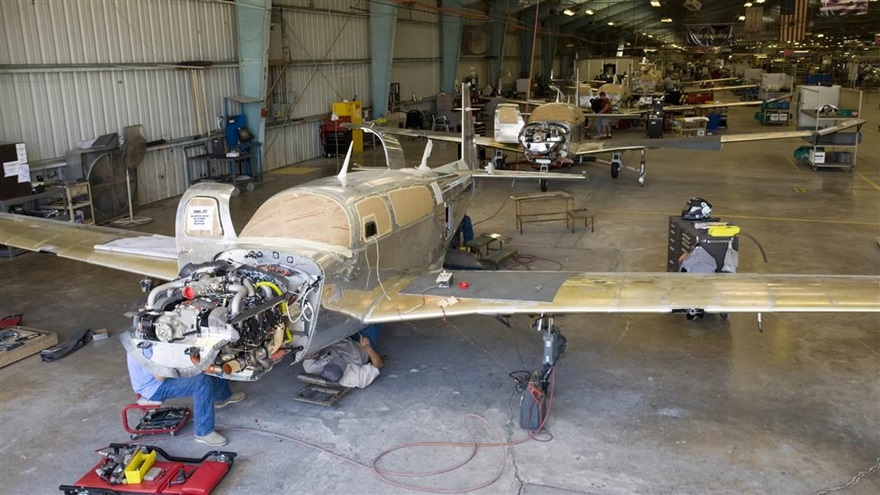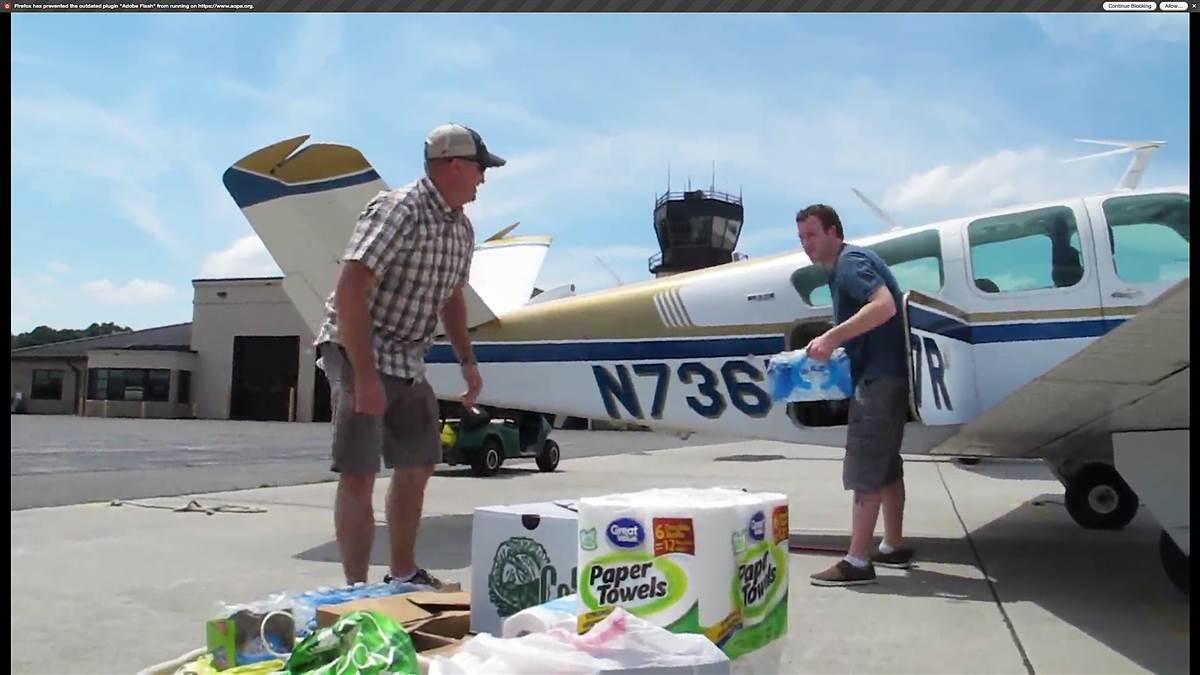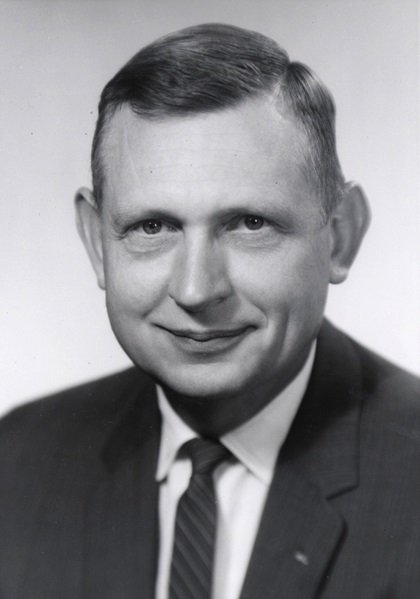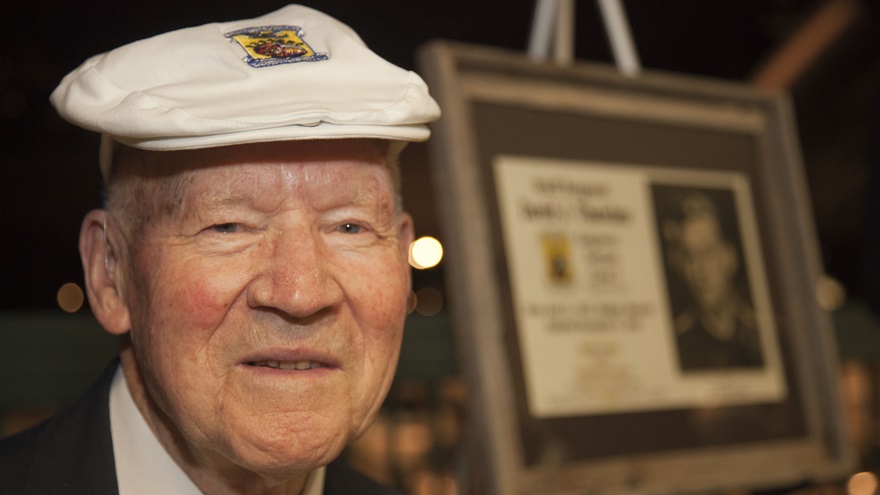Briefing News: Fly Your State—An excellent excuse to fly
State passport programs showcase GA airports

Illustration by Shaw Nielsen
To promote and publicize their general aviation airports, many states across the country have “passport” or ambassador programs in which they offer a passport book that can be stamped to keep a record of landing at each airport; present it to claim an incentive prize. Get a stamp at just five of the 75 Maine airports, for example, and a twin lobster dinner awaits you on the Maine Flying Trail.
 Arkansas. The Arkansas Aviation Ambassador Program challenges you to visit between 30 and 70 airports in the state to qualify for different levels of rebate checks.
Arkansas. The Arkansas Aviation Ambassador Program challenges you to visit between 30 and 70 airports in the state to qualify for different levels of rebate checks.
Maine. The Maine Flying Trail Passport Program helps support tourism in Maine.
Maryland. Explore Maryland by Air encourages pilots to visit both airports and aviation museums in the state and qualify for its Ace-level prize.
Massachusetts. Fly the Bay State Challenge is an ongoing program that not only encourages pilots to fly into all 39 of the state’s public-use airports but also participate in an FAA safety seminar.
Minnesota. Fly Minnesota Airports! awards pilots who visit 130 out of the 136 state airports, visit six museums, and attend six FAA safety seminars with a leather flight jacket.
New Jersey. The New Jersey Airport Challenge is usually a month-long event that awards an instrument-flying course and participant picnic.
North Carolina. Operation: Fly NC encourages pilots to fly to all of the 81 airports in the state, attend four safety seminars, and visit four museums to qualify for flight bags and pilot watches.
North Dakota. Fly North Dakota honors pilots who visit between 30 and 89 of the state’s public-use airports, visit museums, and attend FAA safety seminars. In 2015 11 pilots received the grand prize of a leather flight jacket.
Oregon. Explore Oregon highlights 19 to 20 airports in the state in a six-month air rally; participants qualify for a gift certificate drawing.
South Carolina. The South Carolina Aviation Association encourages pilots to visit all 59 of the state’s public-use airports and attend safety seminars.
South Dakota. Fly South Dakota Airports! awards pilots for visiting between 20 and 74 of the state’s airports with patches, mugs, paperweights, and gift certificates.
Virginia. The Virginia Aviation Ambassadors Program encourages pilots to visit all 66 of the state’s airports, see aviation museums, attend safety seminars, and attend the Virginia Regional Festival of Flight. Win a leather jacket; other incentive prizes are also available.
Email [email protected]
Web: www.aopa.org/pilot/flyyourstate
AOPA NEWS
It passed!
Medical reform becomes law
On July 15, just hours before the FAA’s authorization was set to expire, President Barack Obama signed third class medical reforms into law as part of the FAA authorization extension, which had previously been passed by the House and Senate. Although the extension only keeps the FAA running through September 2017, the medical reforms are permanent, and the FAA has one year to develop and enact rules that will align with the reforms. Pilots will not be allowed to fly under the reforms until the FAA completes its rulemaking or the one-year time limit has elapsed. The FAA has not said when it will begin the rulemaking process or what form that process will take, as of this writing.
Under the reforms, pilots who have held a valid medical certificate any time in the decade prior to July 15, 2016, may not need to take another FAA medical exam. The 10-year lookback period applies to both regular and special issuance medicals. For more details, see “Game Changer” on page 50.
“We have fought long and hard for medical reforms and thanks to the support of GA supporters in both the House and Senate, those reforms are now the law,” said Jim Coon, AOPA senior vice president of government affairs. “We are very pleased that pilots will soon reap the benefits, but the devil is always in the details, and some of those details will be worked out in the rulemaking process. That’s why our team will be closely monitoring the FAA’s next steps, and providing input and the pilot’s perspective at every opportunity.”
FAQs
What is the current state of play?
The FAA will have up to one year to create rules under the provisions of the law. It is in that rulemaking process that many details will be worked out. You can count on AOPA to be there to represent the needs and interests of general aviation pilots at every step along the way.
Who will benefit from this reform?
Hundreds of thousands of pilots can potentially benefit from these reforms, which create an exemption from medical certification requirements. To qualify, you need to hold a current U.S. driver’s license and have held a valid FAA medical certificate, regular or special issuance, within the past 10 years from July 15, 2016. If you’ve never held a medical certificate (student pilots for example), you will need to get an FAA medical certificate from an AME one time only. If your regular or special issuance medical certificate lapsed more than 10 years before July 15, 2016, you will need to get a medical certificate from an AME one time only. And if you develop certain cardiac, neurological, or mental health conditions, you will need a one-time-only special issuance for each condition.
Pilots whose most recent medical certificate has been revoked, suspended, withdrawn, or denied will need to obtain a new medical certificate before they can operate under the new reforms.
What will I have to do in order to benefit from the new reforms?
Once you meet the basic qualifications, you’ll have to take a few steps to fly under the new reforms. At least once every four years, you’ll need to visit a state-licensed physician. At the visit, you’ll need to provide your physician with an FAA-generated checklist, and your physician will need to certify that he or she has performed an examination and discussed all the items on the checklist, including medications, with you. Your physician will have to certify that he is unaware of any medical conditions that, as presently treated, could interfere with your ability to safely operate an aircraft. You will then need to make a note of the visit and include the completed checklist in your logbook. You do not need to report the outcome of the visit to the FAA unless you are specifically requested to do so.
Every two years, you’ll also need to take online training in aeromedical factors and keep the certificate of completion in your logbook.
What operating limitations will apply to pilots flying under the new reforms?
Pilots flying under the new rules will be allowed to operate “covered aircraft” that weigh up to 6,000 pounds and have up to five passenger seats plus the pilot in command, at altitudes below 18,000 feet msl and at speeds of up to 250 knots. Pilots, if appropriately rated, can fly VFR or IFR in covered aircraft. Pilots flying under the exemption cannot operate for compensation or hire.
Web: www.aopa.org/3CM-FAQ
FAA NEWS
Bringing new aircraft to GA
AOPA urges FAA to enact Part 23 changes quickly
By Elizabeth A. Tennyson

AOPA is backing proposed reforms to FAR Part 23 and urging swift implementation while addressing the National Transportation Safety Board’s concerns about changes designed to make it easier to bring new and innovative aircraft to the general aviation market.
In joint comments to the FAA, AOPA and other GA organizations urged the agency to “implement the changes being proposed in as short a time frame as possible,” adding that “this must be an absolute priority for the FAA.” The groups praised the FAA for its efforts to understand and address the industry’s concerns throughout the nine-year process leading up to the current Part 23 rulemaking proposal. And they emphasized the significance of the move toward a more risk-based approach to certification, along with the adoption of industry-consensus standards. The 27 pages of comments, which were signed by AOPA, the General Aviation Manufacturers Association, the Aircraft Electronics Association, and the Experimental Aircraft Association, address detailed technical issues with the notice of proposed rulemaking.
In a separate letter to NTSB Chairman Christopher Hart, AOPA and other GA groups responded to comments filed by the NTSB on the notice of proposed rulemaking. The letter addressed some of the assertions made by the NTSB in its comments.
The industry letter emphasized the economic and safety benefits to come from the proposed use of consensus standards, something the GA industry has long sought. The letter also noted that the NTSB’s discussion of the potential risks was based on problems with an aircraft model that did not conform to industry consensus standards.
AOPA also reminded the NTSB of Part 23 reform’s alignment with the FAA’s risk-based approach to aircraft certification, a philosophy that a single level of safety may not be appropriate for all aircraft certification levels. The letter noted that the NTSB’s concerns over the new certification process appear to have been based upon incidents involving Transport category airplanes certified under Part 25, not Part 23.
“We strongly believe that proposed Part 23—including the use of performance-based regulations and industry-consensus standards—accomplishes this goal and will lay the foundation for the next generation of innovative and safe products for the GA community,” the groups wrote.
More information about proposed changes to Part 23 and what they will mean for GA is available in “Understanding Part 23 Rewrite” (www.aopa.org/Part-23-rewrite).
Email [email protected]
FAA clarifies hangar-use policy
A policy update to the Federal Register focusing on hangar use at federally obligated airports takes effect September 1, 2017, and is meant to be a clarification of “how aviation facilities—including hangars—can be used on airports that receive federal funds,” said the FAA.
Most notably, the update will allow noncommercial experimental and kit aircraft builders to do more work at airport hangars.
In the past, the FAA did not define aircraft building as an aeronautical activity and only final assembly was permitted at hangars on federally obligated airports. The new definition, which AOPA has long fought for, includes noncommercial aircraft construction and not just final assembly.
The FAA also clarified that aircraft down for repair and maintenance are still considered “operational aircraft” and may be kept in hangars at the discretion of airport sponsors.
The update also will allow the storage of nonaeronautical items in hangars provided they do not interfere with the intended aeronautical use of the hangar and are allowed by the airport sponsor.
Finally, for airports with hangar capacity that exceeds local demand, the FAA said, “it is preferable to make use of the hangars to generate revenue for the airport, as long as the hangar capacity can be recovered on relatively short notice for aeronautical use when needed.”
NEWS
Pilots fly disaster-relief supplies to West Virginia
Small airplanes make a big difference
By Alyssa J. Miller
 One by one, airplanes touched down at West Virginia’s Greenbrier Valley Airport in early July filled with disaster-relief supplies from donors in North Carolina and Maryland. Severe storms and rain hit the state in late June, causing floods, landslides, and mudslides that damaged or destroyed thousands of homes. Greenbrier County in the southeastern part of the state was one of the hardest hit. According to the National Weather Service, more than 10 inches of rain fell in parts of Greenbrier County during a 12-hour period. “Return period data suggest this would be nearly a one in a thousand year event,” the service said.
One by one, airplanes touched down at West Virginia’s Greenbrier Valley Airport in early July filled with disaster-relief supplies from donors in North Carolina and Maryland. Severe storms and rain hit the state in late June, causing floods, landslides, and mudslides that damaged or destroyed thousands of homes. Greenbrier County in the southeastern part of the state was one of the hardest hit. According to the National Weather Service, more than 10 inches of rain fell in parts of Greenbrier County during a 12-hour period. “Return period data suggest this would be nearly a one in a thousand year event,” the service said.
Gabriel Glinsky and Jill Cely were eating dinner in North Carolina when they learned of the flood damage and decided to rally the general aviation community to help. Glinsky contacted pilots from his local Experimental Aircraft Association chapter in North Carolina, and AOPA to use airplanes to deliver supplies to the area.
“You think, ‘What can a small little plane do?’” said Glinsky, who organized the effort in just a week. “And then you see this trailer just full of stuff because we all brought a little bit out with us, and it’s just amazing.”
Three Cessna 172s, a V-tail Beechcraft Bonanza, and a Piper Cherokee PA–28-180 brought in about 2,000 pounds of supplies: water, bleach, cleaning supplies, brooms, shovels, toilet paper, paper towels, trash bags, and food.
Glinsky had contacted emergency management in advance of the flight to find out how to coordinate the delivery of supplies and was connected with the Rev. Joshua Saxe, rector of St. James’ Episcopal Church in Lewisburg.
This “is an excellent opportunity for us to take advantage of your capability of transportation, supplies, goods—the needs that we might not be able to get here quickly,” Saxe told the group of pilots who visited the church’s disaster-relief distribution center. Saxe said the area has received many supplies, but added that the recovery phase will be long and that additional supplies and volunteers will be needed for months to come.
“It is a widespread disaster area,” Saxe said, “and we are in it for the long haul.”
Email [email protected]
'The Savvy Flight Instructor' now avialable from ASA
Brand-new flight instructors and seasoned flight school operators alike will find useful advice and plenty of industry insights in the second edition of The Savvy Flight Instructor, now available from Aviation Supplies and Academics. Author Greg Brown is a contributor to Flight Training magazine and writes the monthly “Flying Carpet” column. In addition to networking, pilot training, and customer support concepts, the new edition discusses selling pilot prospects via online marketing, social media, and other contemporary communication channels. The book is available in soft cover ($24.95) and digital ($19.95) versions. See the website to order.
Storied club teaches UAV operators
Longtime San Diego club partners with U.S. Navy
By Matthew Bauman
The Golden State Flying Club has been part of Gillespie Field (SEE), east of San Diego, since 1968. The vision of Steve Mason and Richard Essary, the club was born of a 50-year friendship. While other San Diego flight schools have grown and either focused on training general aviation pilots or solely on professional aviation tracks, Golden State maintains its hangar-flying appeal through close friendships. Retired pilots maintain deep connections after going through training more than 30 years earlier. While many no longer actively fly, numerous alumni return for the club’s annual Christmas celebration, where they meet the newest crop of aspiring pilots and offer more than advice or mentorship. About 40 to 50 pilots currently are in the pipeline working toward various levels of certification.
The club culture and quality instructors explain why Golden State’s reputation is phenomenal. The club hosts various ground schools quarterly, and recently it has experienced a 90-percent initial pass rate on the FAA knowledge tests. Students are required by club policy to achieve 80 percent or above on the three Part 141 course exams prior to instructor signoff for the knowledge test. The lead ground instructor, retired Marine Jeff Warren, ensures all students are prepared. Additional tutoring and instruction are available free of charge during normal club business hours.
Golden State archives student records, allowing students to return and attend any ground school they previously completed free of charge as a refresher. Students who have paused their training or pilots who return to flying after years of inactivity have taken advantage of this opportunity.
The club’s reputation and enthusiasm gained the attention of U.S. Navy officials. The Navy needed training for the next generation of unmanned aerial vehicle (UAV) operators, but was unsure how to go about this. The UAV school, located at Naval Amphibious Base Coronado, initially required students to pass the FAA private pilot knowledge test. Several Navy officers at the school were Golden State members prior to starting their military careers.
Warren had a curriculum that fit the bill for the UAV ground school. The course is an accelerated two-week syllabus Warren comprised from his regular 11-week course. The course was so successful the UAV school plans to have Golden State provide ground school instruction quarterly for future Navy UAV operators.
‘A great ride’
Charles Spence was a journalist drawn to aviation
By Dan Namowitz
 Charles Spence, veteran aviation journalist, newspaperman, pilot, and former AOPA senior vice president of public relations, died June 23. He was 94.
Charles Spence, veteran aviation journalist, newspaperman, pilot, and former AOPA senior vice president of public relations, died June 23. He was 94.
Spence, who retired at the end of 2014 from his most recent post covering the Washington beat for General Aviation News, was a pilot with single-engine, multiengine, and instrument ratings who once wrote that his interest in flying was what channeled him to aviation journalism during a 76-year career he called “a great ride.”
“Charlie was a vocal advocate for pilots and AOPA members, and a true believer in the value and importance of general aviation,” said AOPA President Mark Baker. “Never afraid to do battle for what he believed, Charlie had a way of getting straight to the point and distilling complex issues to their essence. During his years at AOPA and beyond, he worked tirelessly to ensure that general aviation got a fair shake. He will be greatly missed,” Baker said.
Spence was born in New Albany, Indiana. He was drawn to newspapers at an early age, working evenings and after school at the Louisville, Kentucky, Courier-Journal and Times beginning at age 16. Spence served in the U.S. Marine Corps during World War II and worked at a number of newspapers and Hearst Promotion Enterprises.
Spence began his work in aviation journalism at Flying magazine, and he moved to the nation’s capital to work for the Utility Airplane Council, a forerunner of the General Aviation Manufacturers Association. Spence worked at AOPA from 1968 to 1983 and was senior vice president of public relations from 1980 to 1983. He was a colleague and the biographer of Max Karant, who founded AOPA Pilot magazine in 1958.
After some time freelancing for the Flyer newspaper, predecessor of General Aviation News, Spence began reporting for the publication from Washington, D.C.
Spence is survived by his son Craig Spence, the secretary general of the International Council of Aircraft Owner and Pilot Associations and an adviser to AOPA on security issues.
Email [email protected]
Doolittle Raider Thatcher dies
 David J. Thatcher, who was an engineer-gunner on the mission to bomb Tokyo under the command of then-Lt. Col. James H. “Jimmy” Doolittle, died June 22 at the age of 94 in Missoula, Montana. Richard Cole, Doolittle’s co-pilot on the mission, is the last surviving Raider.
David J. Thatcher, who was an engineer-gunner on the mission to bomb Tokyo under the command of then-Lt. Col. James H. “Jimmy” Doolittle, died June 22 at the age of 94 in Missoula, Montana. Richard Cole, Doolittle’s co-pilot on the mission, is the last surviving Raider.
Thatcher was a member of crew number 7 on the April 18, 1942, raid, manning the top turret of a North American B–25B Mitchell bomber. After bombing Tokyo, the crew flew toward China but ran low on fuel and ditched in waist-deep water off the coast. The Chinese helped Thatcher and the rest of his crew evade the Japanese and make it to a hospital a few days later. He received a Silver Star for his efforts.
Thatcher served as an engineer-gunner on a Martin B–26 Marauder in North Africa before being discharged from the military in 1945. Thatcher also received the Distinguished Flying Cross; Air Medal with four Oak Leaf Clusters; and the Chinese Army, Navy and Air Corps Medal, Class A, 1st Grade.
“He was a true hero,” said Brian Anderson, Doolittle Tokyo Raiders sergeant at arms.
The Doolittle Tokyo Raiders were awarded the Congressional Gold Medal in 2015, and Thatcher and Cole donated the medal to the National Museum of the U.S. Air Force. —Alyssa J. Miller
September 24, 1929
This month in aviation
“I flew the plane down to the ground using the instrument landing procedure we had developed. The whole flight lasted only 15 minutes. So far as I know, this was the first time an airplane had taken off, flown over a set course, and landed by instruments alone.”
Lieutenant James H. Doolittle, U.S. Army Air Corps, guides a Consolidated NY–2 biplane over Mitchell Field in New York in the first all-instrument flight.


